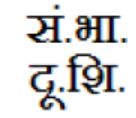 |
Distance Learning Program (DLP) - दूरस्थशिक्षणम्
|
 |
DLP Syllabus for Children Track
bhUmikA introduces the language. PraveshaH 1 (BPR1) builds upon prior devanAgarI knowledge and covers the aspects of nouns, using verbs in the present tense. PraveshaH 2 (BPR2) continues from bAla pravEshaH I and covers study of verbs in different tenses and moods, and some conversions of verbs into nouns. The two exams will carry the equivalence of taking the common PraveshaH exam (that adults take).
Click here for a PDF Version of the Syllabus
1 bAla bhUmika
This course will help students interested in learning Samskritam but do not have classes available locally. The course is geared to introduce the participants in having a basic knowledge of Samskritam. This is a 16-week class, where the students will be introduced to Samskritam - sounds (listening and speaking) & letters (reading and writing), words and sentences. There will be homework assigned.
Medium of Instruction is English.
2 kathA shrAvaNam (S1/S2) - Optional
Once the bhUmika classes are completed, the children will be able to opt for this additional 16-week (once every two weeks) class where the orientation is towards enabling the child to storytelling/listening to samskritam stories.
Medium of Instruction is English.
3 pallavam Exam Prep (P1/P2) - Optional
Once the bhUmika classes are completed, the children will be able to opt for this additional 16-week (once every two weeks) class where the orientation is towards preparing for the Pallavam exam.
Medium of Instruction is English.
4 PraveshaH-I (BPR1)
Students who already know the devanAgarI script will be introduced formally to the role of nouns in sentence construction. These vibhaktis will be studied in full detail. This will constitute the first half of the study of pravesha material. There will be homework assigned. And a test at the end of the course leading to a certificate
Medium of Instruction is English. But, the answers are expected to be written in Samskritam unless otherwise stated. bAla pravEsha broadly covers the following topics:
- Sayings
- parasmaipadinaH – present tense – in all three counts and persons
- Nouns – in 3 genders, pronouns (in all 3 persons), all case endings and their role in sentence formation. Covers words that end in vowels / consonants
- Numbers – general, 1 to 100
- Vocabulary, Riddles
- Operational Samskritam, Collection of shlokAH
- Introduction to Samskrita literature
5 PraveshaH-II (BPR2)
Medium of some of the Instructions is in English. But, the answers are expected to be written in Samskritam unless otherwise stated. bAla PravEshah-II covers the following topics:
- AtmanepadinaH – present tense. Both (parasmai & Atmane) – past & future tenses, request. pratyayAH – ktavatu, ktvA, lyap, tumun, lyuT, classifications, tenses & moods, voices
- Prefixes
- Collection of shlokAH
- Introduction to Samskrita literature
- kathAH – stories
- subhAShitams
6 ParichayaH-I (BPA1)
Medium of some of the Instructions is in English. But, the answers are expected to be written in Samskritam unless otherwise stated. covers the following topics:
- Sayings
- Grammar portion
- Vocabulary (nouns)
- Witty Sayings
- Vocabulary (verbs)
- Sandhi
7 ParichayaH-II (BPA2)
Medium of some of the Instructions is in English. But, the answers are expected to be written in Samskritam unless otherwise stated. covers the following topics:
- Riddles
- Subhashitam
- Kavyams presented as prose (stories)
- Parsing of shlokas
- Translation methodologies
- Miscellaneous collection

